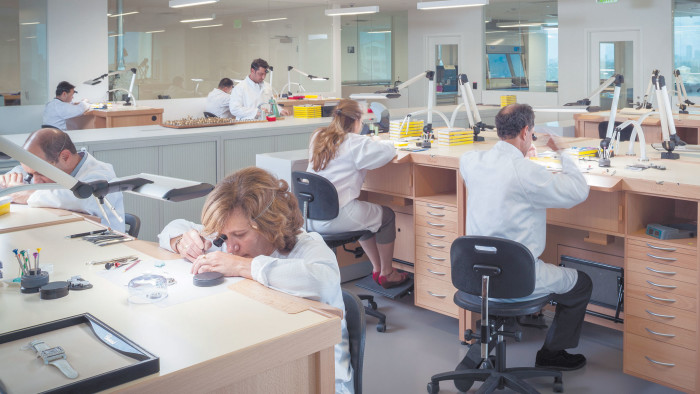Patek Philippe and Chopard expand US aftersales watch workshops

Roula Khalaf, Editor of the FT, selects her favourite stories in this weekly newsletter.
Aftersales workshops are less glamorous than boutiques, but they are vital to luxury watch companies. Now, Chopard and Patek Philippe have turned their workshops into marketing assets by placing them centre stage as they seek to satisfy customers’ expectations.
“As [luxury brands] build a nice big presence in important parts of important cities, it helps the brand in total,” says Matt Jacobson, Facebook’s head of market development and a keen collector of Rolex and Patek Philippe timepieces.
Mr Jacobson cites the Apple store model: consumers have no reason to buy products at an Apple store other than the reassurance of doing so – very different for the retailer than sending products off in a box. “I’d rather hand a watch to somebody then send it to somebody,” he says.
The logic for watchmakers of the “workshop-as-customer-experience” is simple. Typically, aftersales service involves sending the timepiece to Geneva, often for many months. The process can range from simple procedures such as a check-up or aesthetic service (usually recommended every two years) to a complete overhaul (every four or five years), which allows for a full inspection of the timepiece’s most technical and precise aspect: its mechanism.
Until recently, a Patek Philippe watch sent from the US to Geneva for servicing was expected to be gone for three months.
Servicing a luxury watch is expensive, but that does not seem to put customers off. “People rarely complain about our pricing. What they complain about is they want their watch back,” says Larry Pettinelli, Patek Philippe’s US president.
To tackle the problem – and customers’ frustrations – in 2013, the Henri Stern Watch Agency, Patek Philippe’s US subsidiary, signed a 15-year lease (negotiated at the height of the economic recession when rents were at their most favourable for tenants) on a sprawling new, 33,000 sq ft office at 45 Rockefeller Plaza, more than doubling its US workshop space in the process.
“The more we can repair in the local market, the better off our clients and retailers, who won’t have to explain why a simple repair takes three months, will be,” says Mr Pettinelli. “That definitely impacts the sale of the next piece. We don’t want to put up roadblocks for our retailers.”
The workshop is now the largest outside Geneva, with room for 40 watchmakers (the company currently has 19 in the US).
Similarly, Chopard last year opened an 11,000 sq ft customer service centre in the Miami suburb of Coral Gables. The workshop enables more timepieces to be serviced in the growing American markets, including special pieces that in the past had to be sent to Switzerland.
Karl-Friedrich Scheufele, Chopard’s co-president, says the centre complements an existing Manhattan townhouse facility and makes it possible to double the number of domestic repairs. The move was part of a five-year project that followed a customer survey in which aftersales service received less than enthusiastic approval.
“We were average, but not excellent,” he says. “It wasn’t easy; it was as much a logistical overhaul as it was a change of culture.”
Retaining customers is paramount, particularly in the US, where Chopard’s business has increased steadily over the past decade. Aftersales has become a selling point for the brand.
Mr Scheufele says the company has managed to cut the average global turnround time by 11 days to 12. “And there’s nothing more important than someone talking about the great experience he or she had,” he says.
Chris Barry, a collector based in the US, bought his second Chopard watch partly because he was impressed by the company’s aftersales service. “I didn’t feel like I was just another number,” says the 30-year-old, New Jersey-based sales executive. His warranty is extended for one year after each service but more important to him is the individual attention he receives.
That relationship is important for watch brands as they seek to retain young clients graduating to their next level of watch buying.
“You only think of service when the time comes or when you have a mechanical problem, but it’s good to know it’s there for you when it does arise,” adds Mr Barry. “It takes a bit of the bad side of the hobby and makes it more user-friendly.”
In the US alone, between 9,000 and 10,000 Patek Philippe watches are serviced each year. The company’s retailers are regularly given tours of the facility, where nearly 9,000 sq ft is dedicated to the workshop. VIP customer and other PR events include the workshop as a tour highlight.
The reception area is designed to educate: interactive walls showcase the brand’s history while a camera system provides a live stream feed into the workshop.
But this commitment to the future is also a money-losing proposition. “There is no return on investment,” Mr Pettinelli says. “The return is good will and satisfying the customer.
“Frankly speaking, we look to break even every year on servicing; we usually are in the red.” But he adds: “If we don’t service customers at this level with expectations as high as they are, we won’t sell that extra watch.”
John Reardon, senior vice-president of the watches department at Christie’s in New York, who previously worked at Patek Philippe USA, confirms the value for companies of investing in aftersales.
A highlight of Christie’s New York Important Watches sale last December was an 18ct gold Patek Philippe Perpetual Calendar Chronograph. The timepiece, manufactured in 1960 and cared for by Patek since day one, sold for $725,000 – nearly matching its high estimate.
Much of the value that Patek Philippe watches retain at auction is down to the brand’s commitment to servicing every watch made since the company was founded in 1839, Mr Reardon says.
“The pay-off is protecting the brand’s heritage and preserving treasured timepieces for generations to come.”
Comments